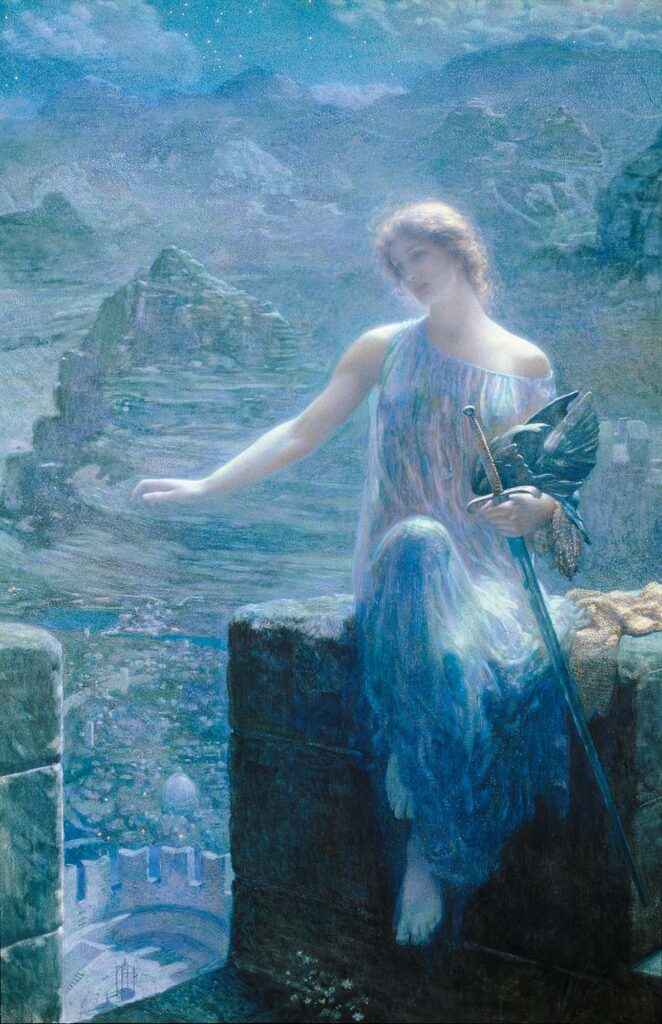
The Valkyrie’s Vigil, by Edward Robert Hughes, credit Wikipedia
Endnotes, February 2024
Wagner from Denmark, reviewed by Stuart Millson
Die Walküre (The Valkyrie) by Richard Wagner is a music-drama comprising three Acts and forms the second part of the composer’s epoch-making operatic achievement, Der Ring Des Nibelungen (The Ring of the Nibelungs). Set in the Teutonic forests in a time out of mind, the opera was first produced at Munich in the June of 1870, but as music-writer J. Walker McSpadden notes in Opera Synopses, it, did not receive a performance to the composer’s exacting standards until the August of 1876, when it came to the stage of Wagner’s own Bayreuth opera-house. And as McSpadden also observes:
“In order to understand the purport of “Die Walküre” as related to the “Ring” a certain amount of narrative is necessary which is not represented on the stage. Wotan, foreseeing the doom of the gods because they are pledged to respect the power of the magic ring, endeavours to protect Walhalla by creating a band of Valkyrie or warrior-maidens; their duty is to convey on their winged steeds the bodies of the noblest warriors, slain upon the field of battle, to the abode of the gods, where the warriors will live again, a mighty race to defend Walhalla. Upon the earth, also, Wotan has begotten two children of his own, Siegmund and Sieglinde, who grow up in ignorance of each other.”
To provide us with a revelatory reading of this opera, the STERLING CD label has issued a three-disc box set of a 1987 live recording, given at Den Jyske Opera, Aarhus; the Aarhus Symphony Orchestra, conducted by Francesco Cristofoli, with ~ centre-stage ~ the distinguished soprano, Laila Andersson-Palme as the Valkyrie, Brunnhilde.
The curtain goes up and a storm is raging through the German forests ~ the hut of Hunding (sung by Aage Haugland, bass) providing shelter to Siegmund (Sven-Olof Eliasson) who, we learn, is a foe of Hunding. Sieglinde (Lisbeth Balslev), Hunding’s wife, ushers Siegmund in from the gale, but as they converse, a (fatal) attraction begins to envelope them, despite their true relationship ~ unknown to each other… of brother and sister.
For a 1987 recording, a live one at that, one might think that the sound quality might even now seem somewhat dated, or at least surpassed by today’s gleam of a perfectly recorded orchestral palette. Not a bit of it. Put your headphones on, close your eyes and revel in the magnificent sound of the Aarhus Symphony Orchestra; its rich, melancholy cello playing, and throughout the string section, the immediacy, the close-up, gutsy sound of real, present-before-you violins ~ not a studio-engineered sheen.
From the gripping, nervous, even terrifying opening tempest, to the long, involved Scene 2 ensemble of Hunding, Sieglinde and Siegmund, to the surging conclusion to Act 1, Denmark’s (perhaps) lesser-known orchestra truly rivals Bayreuth or Berlin. A Lohengrin-like nobility, seemingly a quotation from an idea in Wagner’s 1850 opera of the same name, rises in the music ~ and in the sensational horn and brass writing, it becomes clear how Wagner ‘mapped out’ the future symphonic scores of Bruckner and Mahler. Yet so far, we have not yet encountered Brunnhilde, who is to appear in Act ll ~ the great god Wotan summoning his favourite of the Valkyrie maidens, to deliver Siegmund to face his enemy, a task she finds impossible to carry out, sheltering both him and his love, Sieglinde. (And in this time, the future has taken root: the child, Siegfried ~ the subject of the third part of The Ring cycle ~ will be born from the union of the fleeing lovers.)
Brunnhilde’s defiance of Wotan (sung by the splendidly-named bass-baritone, Leif Roar) is one of the great moments in Wagner, and it is clear from this Danish performance that Laila Andersson-Palme has the full measure of her brave, but foolhardy character ~ foolhardy, because she ends the opera, thanks to Wotan, on an inaccessible mountain peak, cut off from the world by a circle of magic fire, which only a true hero could breach.
This Wagner box set is a firmly recommended for those who seek true realism in their listening, not just the authentic Wagnerian atmosphere generated by the singers and orchestral players, but by the inclusion of the wild applause of that 1987 Danish audience ~ transporting you to the very edge of the stage. And with an informative booklet, synopsis and interview with Laila Andersson-Palme in which she discusses her career and the challenges of performing Wagner, this is an opera CD not to be missed.
CD details: Wagner, Die Walküre, Aarhus Symphony Orchestra/Cristofoli. STERLING CDA 1870, 1871, 1872.
Stuart Millson is the Classical Music Editor of The Quarterly Review











“No Wagner, no Holocaust”?
Carolyn S. Ticker, DigitalCommons@Cedarville, Fall 2016, online
“No St John & St Paul, No Tertullian & Augustine, No Chrysostom & Luther, No Holocaust”?
“The [Nazi] CHOICE of the Jews as a target arose DIRECTLY out of centuries of CHRISTIAN teaching which had SINGLED OUT the Jews as a demonic people DEDICATED to EVIL” (Hyam Maccoby).